No edit summary Tag: Visual edit |
Tag: Visual edit |
||
| (7 intermediate revisions by 3 users not shown) | |||
| Line 3: | Line 3: | ||
'''The Realm of the Stars''' transported guests to a futuristic space station, in which every detail mimicked the lifestyle of a near-future astronaut. |
'''The Realm of the Stars''' transported guests to a futuristic space station, in which every detail mimicked the lifestyle of a near-future astronaut. |
||
| − | As guests explored this astronomical world, the picture that emerged was one of a cosmos in ongoing flux, in which nebulae, stars, |
+ | As guests explored this astronomical world, the picture that emerged was one of a cosmos in ongoing flux, in which nebulae, stars, planets, and even galaxies themselves are constantly forming, evolving, colliding, and decaying. |
This theme of perpetual galactic change was subtly hinted at throughout the Realm (for example, in the presence of swirling gas-giant planets outside many of the space station's windows) -- and it was expressed vividly and explicitly in the Realm's main attraction, Nebula Quest. |
This theme of perpetual galactic change was subtly hinted at throughout the Realm (for example, in the presence of swirling gas-giant planets outside many of the space station's windows) -- and it was expressed vividly and explicitly in the Realm's main attraction, Nebula Quest. |
||
| Line 15: | Line 15: | ||
In some hallways, inward-facing "windows" looked out on facilities such as a shuttle manufacturing center, as well as on a hydroponic vegetable farm, a fish hatchery, staff living quarters, and other components of the space station (all cleverly and realistically simulated through the use of miniatures and video screens). |
In some hallways, inward-facing "windows" looked out on facilities such as a shuttle manufacturing center, as well as on a hydroponic vegetable farm, a fish hatchery, staff living quarters, and other components of the space station (all cleverly and realistically simulated through the use of miniatures and video screens). |
||
| − | [[File:Space Station Central Chamber.jpg|left|thumb|323x323px| |
+ | [[File:Space Station Central Chamber.jpg|left|thumb|323x323px|Orbit One Central, as it looked circa 1985]] |
| − | At the center of the station was |
+ | At the center of the station was [[Orbit One Central]], an indoor mini-mall where guests could shop for futuristic souvenirs, sample a variety of freeze-dried treats at the [[Cosmos Cafe|Cosmonaut Cafe]], or just relax on padded benches and watch galaxies and nebulae drift by through wall-length windows. |
| − | + | Orbit One Central also offered a wide variety of interactive activities, which evolved to keep pace with developing technology throughout OmniPark's 25 years in operation. |
|
| − | At the park's opening in 1977, guests could play with Moog synthesizers and other audiovisual gadgets. In 1985, the exhibits were renovated to feature user-friendly computer terminals that allowed guests to generate colorful geometric imagery and compose digital music. |
+ | At the park's opening in 1977, guests could play with Moog synthesizers and other audiovisual gadgets. In 1985, the exhibits were renovated to feature user-friendly computer terminals that allowed guests to generate colorful geometric imagery and compose digital music. Orbit One Central's activities were revamped for a third time in 1993, to feature touchscreens and computer-animated visuals. A final renovation in 1999 added terminals at which guests could customize 3-D avatars of themselves, and play a virtual reality game in which they navigated a hazardous asteroid field. |
==Attraction: Nebula Quest== |
==Attraction: Nebula Quest== |
||
[[File:Nebula Quest ride vehicles.png|left|thumb|327x327px|1975 OmniPark Concept art for Nebula Quest ride vehicles]] |
[[File:Nebula Quest ride vehicles.png|left|thumb|327x327px|1975 OmniPark Concept art for Nebula Quest ride vehicles]] |
||
| − | The largest portal opening off |
+ | The largest portal opening off Orbit One Central featured an illuminated sign beckoning guests to "Nebula Quest: An Intergalactic Hyperspace Adventure." While waiting in line, guests were treated to an awe-inspiring view of the station's main docking bay, through which they watched starships arrive, dock, unload, and depart for far-off destinations. |
| − | Once guests arrived at the ride itself, they boarded spherical vehicles, each seating two guests side-by-side. Upon entering the vehicle and being secured by a lap bar, the vehicles would immediately rotate ninety degrees, turning away from the space station to reveal a breathtaking concave [[Omnivision|OmniVision]] vista in which they were suspended far above a looming planet Earth. It was here that guests were introduced to the [[The Navigator|Navigator]], an astronaut |
+ | Once guests arrived at the ride itself, they boarded spherical vehicles, each seating two guests side-by-side. Upon entering the vehicle and being secured by a lap bar, the vehicles would immediately rotate ninety degrees, turning away from the space station to reveal a breathtaking concave [[Omnivision|OmniVision]] vista in which they were suspended far above a looming planet Earth. It was here that guests were introduced to the [[The Navigator|Navigator]], an astronaut of considerable experience. |
[[File:9673b64d5db743b386e532b9ca1f5493.jpg|thumb|357x357px|The chamber in which riders underwent "hyperspace jumps," as it looked circa 1985]] |
[[File:9673b64d5db743b386e532b9ca1f5493.jpg|thumb|357x357px|The chamber in which riders underwent "hyperspace jumps," as it looked circa 1985]] |
||
| − | After the guests had a few moments to take in the sheer scale of outer space, the Navigator revealed that she'd decided to bring them along for a special mission: to attempt to locate a nebula that was photographed by one of the station's telescopes, but had then vanished mysteriously. The search for this lost nebula, the Navigator explained, provided an ideal opportunity to test-drive the |
+ | After the guests had a few moments to take in the sheer scale of outer space, the Navigator revealed that she'd decided to bring them along for a special mission: to attempt to locate a nebula that was photographed by one of the station's telescopes, but had then vanished mysteriously. The search for this lost nebula, the Navigator explained, provided an ideal opportunity to test-drive the [[The Physicist|Physicist]]'s new [[Hyperspace Ring]], and explore the cosmos firsthand. |
The ride vehicles then undertook the first of several "hyperspace jumps" -- which were actually rotations through a chamber positioned opposite the OmniVision screen. Disoriented by a field of laser light accompanied by digital sound effects, along with dizzying rotations of the ride vehicle itself (accomplished by a proprietary gyroscopic system), few guests realized their ride vehicles were simply rotating back around to the same enormous OmniVision screen, where different nebulae, galaxies and constellations were projected at each "destination." |
The ride vehicles then undertook the first of several "hyperspace jumps" -- which were actually rotations through a chamber positioned opposite the OmniVision screen. Disoriented by a field of laser light accompanied by digital sound effects, along with dizzying rotations of the ride vehicle itself (accomplished by a proprietary gyroscopic system), few guests realized their ride vehicles were simply rotating back around to the same enormous OmniVision screen, where different nebulae, galaxies and constellations were projected at each "destination." |
||
| − | Riders emerged from the first hyperspace jump to arrive at a view of the solar system from just beyond the planet Pluto. After allowing them a moment to take in the view, the Navigator announced excitedly that the first test of the hyperspace system had successfully transported them four billion miles from the sun -- farther than any living beings had ever traveled before. They were the humans, she explained in awed tones, ever to personally see their own solar system from the outside. |
+ | Riders emerged from the first hyperspace jump to arrive at a view of the solar system from just beyond the planet Pluto. After allowing them a moment to take in the view, the Navigator announced excitedly that the first test of the hyperspace system had successfully transported them four billion miles from the sun -- farther than any living beings had ever traveled before. They were the first humans, she explained in awed tones, ever to personally see their own solar system from the outside. |
[[File:491f16f14c45755a72df54239b1402ac.jpg|left|thumb|299x299px|1975 OmniPark concept art for one of the nebular vistas]] |
[[File:491f16f14c45755a72df54239b1402ac.jpg|left|thumb|299x299px|1975 OmniPark concept art for one of the nebular vistas]] |
||
Now it was time to go in search of the missing nebula. A series of rapid hyperspace jumps transported riders to famous interstellar structures such as the [https://www.wikiwand.com/en/Crab_Nebula Crab Nebula], the [https://www.wikiwand.com/en/Cat%27s_Eye_Nebula Cat's Eye Nebula], and the [https://www.wikiwand.com/en/Engraved_Hourglass_Nebula Hourglass Nebula], all visually simulated through chemical photography and projected at impressive scale on the Omnivision screen. At each stop, the Navigator scanned her instruments for the missing nebula, but was unable to find any trace of it. |
Now it was time to go in search of the missing nebula. A series of rapid hyperspace jumps transported riders to famous interstellar structures such as the [https://www.wikiwand.com/en/Crab_Nebula Crab Nebula], the [https://www.wikiwand.com/en/Cat%27s_Eye_Nebula Cat's Eye Nebula], and the [https://www.wikiwand.com/en/Engraved_Hourglass_Nebula Hourglass Nebula], all visually simulated through chemical photography and projected at impressive scale on the Omnivision screen. At each stop, the Navigator scanned her instruments for the missing nebula, but was unable to find any trace of it. |
||
| Line 42: | Line 42: | ||
Further jumps transported guests to the [https://www.wikiwand.com/en/Andromeda_Galaxy Andromeda Galaxy], 2.5 million light years from earth -- then outside the [https://www.wikiwand.com/en/Virgo_Supercluster Virgo Supercluster], which contains the Milky Way and Andromeda galaxies along with thousands of others. |
Further jumps transported guests to the [https://www.wikiwand.com/en/Andromeda_Galaxy Andromeda Galaxy], 2.5 million light years from earth -- then outside the [https://www.wikiwand.com/en/Virgo_Supercluster Virgo Supercluster], which contains the Milky Way and Andromeda galaxies along with thousands of others. |
||
[[File:5a694f8b25a0da6dc4974fbc24fd8ed8.jpg|thumb|362x362px|1975 OmniPark Concept art Nebula Quest]] |
[[File:5a694f8b25a0da6dc4974fbc24fd8ed8.jpg|thumb|362x362px|1975 OmniPark Concept art Nebula Quest]] |
||
| − | At this point, the distressed Navigator revealed she'd been hiding a key piece of information from the riders: each of these hyperspace jumps was taking them not only farther out in space, but also ''further forward in time''. While this effect was negligible within the solar system and its immediate environs, these million-light-year jumps had taken them millions of years into the future. Everyone they had ever known was long-dead. Even the planet Earth itself might have plunged into the sun by now.<blockquote> </blockquote>{{Item}}A hyperspace jump back into the Virgo Supercluster revealed that the Navigator's worst fears were correct: no known galaxies remained. The Milky Way and Andromeda Galaxies had long-since collided, merging into a new galaxy while sending untold billions of worlds and solar systems hurtling outward into deep space. Further jumps transported riders back to the Hourglass and Cat's Eye Nebulae, which had taken on strange new shapes as millions of years had passed.<blockquote>"''One of two things will happen: either we are obliterated ...or we become gods!''"</blockquote><blockquote>— The Navigator</blockquote>And this time-warping effect, the Navigator admitted, explained why she was unable to find the lost nebula: like everything else in the universe, ''it was constantly changing'', slowly falling apart, giving in to entropy. "Nothing lasts forever," she explained. "Nothing is static; nothing is constant. Not the planet Earth, not our sun, or our galaxy; not even the universe itself. The only thing that is truly real ...is change itself." |
+ | At this point, the distressed Navigator revealed she'd been hiding a key piece of information from the riders: each of these hyperspace jumps was taking them not only farther out in space, but also ''further forward in time''. While this effect was negligible within the solar system and its immediate environs, these million-light-year jumps had taken them millions of years into the future. Everyone they had ever known was long-dead. Even the planet Earth itself might have plunged into the sun by now.<blockquote> </blockquote>{{Item}}A hyperspace jump back into the Virgo Supercluster revealed that the Navigator's worst fears were correct: no known galaxies remained. The Milky Way and Andromeda Galaxies had long-since collided, merging into a new galaxy while sending untold billions of worlds and solar systems hurtling outward into deep space. Further jumps transported riders back to the Hourglass and Cat's Eye Nebulae, which had taken on strange new shapes as millions of years had passed.<blockquote>'''"''One of two things will happen: either we are obliterated ...or we become gods!''"'''</blockquote><blockquote>'''— The Navigator'''</blockquote>And this time-warping effect, the Navigator admitted, explained why she was unable to find the lost nebula: like everything else in the universe, ''it was constantly changing'', slowly falling apart, giving in to entropy. "Nothing lasts forever," she explained. "Nothing is static; nothing is constant. Not the planet Earth, not our sun, or our galaxy; not even the universe itself. The only thing that is truly real ...is change itself." |
But there was one possible hope, the Navigator declared -- an idea so crazy it just might work: she could launch them on a jump that took them straight through a black hole, which (according to one fringe theory) might punch a hole ''outside the physical universe itself'', enabling the Navigator to plot a course back around the curve of spacetime, and back to the year from which they'd left. "One of two things will happen," the Navigator cried, in one of OmniPark's most memorable lines: "either we are obliterated ...or we become gods!" |
But there was one possible hope, the Navigator declared -- an idea so crazy it just might work: she could launch them on a jump that took them straight through a black hole, which (according to one fringe theory) might punch a hole ''outside the physical universe itself'', enabling the Navigator to plot a course back around the curve of spacetime, and back to the year from which they'd left. "One of two things will happen," the Navigator cried, in one of OmniPark's most memorable lines: "either we are obliterated ...or we become gods!" |
||
| Line 55: | Line 55: | ||
== Controversy and Renovations == |
== Controversy and Renovations == |
||
| − | Although guest polls found that Nebula Quest was one of OmniPark's most popular attractions throughout the late 1970s '''[citation needed]''', the ride soon came under heavy fire from the scientific community for its "highly questionable" astrophysics. |
+ | Although guest polls found that Nebula Quest was one of OmniPark's most popular attractions throughout the late 1970s '''<sup>[[https://en.wikipedia.org/wiki/Wikipedia:Citation_needed citation needed]]</sup>''', the ride soon came under heavy fire from the scientific community for its "highly questionable" astrophysics. |
"The singularity of a black hole is just that: a singular point in spacetime," astrophysicist Carl Sagan wrote in his 1980 ''Scientific American'' article [[The Real Science Behind OmniPark|''The Real Science Behind OmniPark'']]. "Talking about 'punching through' it makes no sense, any more that one could 'punch through' an electron with a pencil." |
"The singularity of a black hole is just that: a singular point in spacetime," astrophysicist Carl Sagan wrote in his 1980 ''Scientific American'' article [[The Real Science Behind OmniPark|''The Real Science Behind OmniPark'']]. "Talking about 'punching through' it makes no sense, any more that one could 'punch through' an electron with a pencil." |
||
| Line 61: | Line 61: | ||
Stephen Hawking offered a somewhat more generous (but also critical) take in his 1988 book [https://www.wikiwand.com/en/A_Brief_History_of_Time ''A Brief History of Time''], which mentioned Nebula Quest in passing: "While it is mathematically possible that a black hole could, in fact, serve as a hole through spacetime," he wrote in chapter 10, "all the matter in your body would be compressed to an infinitely tiny mass of infinite density by the time you entered it: not exactly an ideal state in which to travel." |
Stephen Hawking offered a somewhat more generous (but also critical) take in his 1988 book [https://www.wikiwand.com/en/A_Brief_History_of_Time ''A Brief History of Time''], which mentioned Nebula Quest in passing: "While it is mathematically possible that a black hole could, in fact, serve as a hole through spacetime," he wrote in chapter 10, "all the matter in your body would be compressed to an infinitely tiny mass of infinite density by the time you entered it: not exactly an ideal state in which to travel." |
||
| − | Nebula Quest's concepts of traveling "outside the universe" and along the "outer curve of spacetime" also attracted harsh criticism from physicists, many of whom protested that OmniPark had no business masquerading as an educational theme park if its attractions were based on such nonsensical premises '''[citation needed]'''. In addition, many guests complained that the gyroscopic rotations of final hyperspace journey made them nauseous '''[citation needed].''' |
+ | Nebula Quest's concepts of traveling "outside the universe" and along the "outer curve of spacetime" also attracted harsh criticism from physicists, many of whom protested that OmniPark had no business masquerading as an educational theme park if its attractions were based on such nonsensical premises '''<sup>[[https://en.wikipedia.org/wiki/Wikipedia:Citation_needed citation needed]]</sup>'''. In addition, many guests complained that the gyroscopic rotations of the final hyperspace journey made them nauseous '''<sup>[[https://en.wikipedia.org/wiki/Wikipedia:Citation_needed citation needed]]</sup>.''' |
In a rare instance of openly bowing to public criticism, OmniPark management formally recruited a board of scientific advisors in 1989, and revised the ride's plot according to their critiques. The revamped version of Nebula Quest entirely eliminated the concept of traveling millions of years into the future. Instead, new recordings of the Navigator explained these climactic scenes in terms of space travel, not time travel; and the return to Earth was accomplished via a series of (apparently more plausible) ordinary hyperspace jumps. |
In a rare instance of openly bowing to public criticism, OmniPark management formally recruited a board of scientific advisors in 1989, and revised the ride's plot according to their critiques. The revamped version of Nebula Quest entirely eliminated the concept of traveling millions of years into the future. Instead, new recordings of the Navigator explained these climactic scenes in terms of space travel, not time travel; and the return to Earth was accomplished via a series of (apparently more plausible) ordinary hyperspace jumps. |
||
Latest revision as of 22:58, 1 June 2020

The OmnIcon of the Realm of the Stars
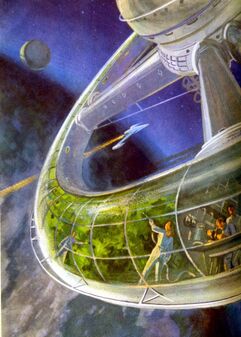
1977 publicity art for the Realm of the Stars
The Realm of the Stars transported guests to a futuristic space station, in which every detail mimicked the lifestyle of a near-future astronaut.
As guests explored this astronomical world, the picture that emerged was one of a cosmos in ongoing flux, in which nebulae, stars, planets, and even galaxies themselves are constantly forming, evolving, colliding, and decaying.
This theme of perpetual galactic change was subtly hinted at throughout the Realm (for example, in the presence of swirling gas-giant planets outside many of the space station's windows) -- and it was expressed vividly and explicitly in the Realm's main attraction, Nebula Quest.
Realm Layout and Design[]
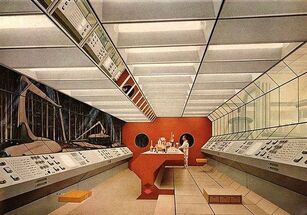
A hallway with windows looking out on a "starship manufacturing plant"
Guests entered the realm by taking seats in a "rocket," which took them through an exciting "blastoff" sequence, followed by a graceful docking sequence clearly inspired by 2001: A Space Odyssey. Once the "airlock" was sealed, guests were free to cross into the space station and explore the Realm within.
The Realm itself was designed on the plan of a ring-shaped space station, aesthetically similar to spacecraft seen in mid-century science fiction films like 2001.
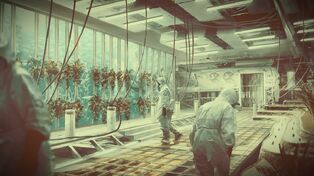
1975 OmniPark concept art for the hydroponic farm visible from one of the station's interior windows
As guests wandered around the ring, they would be treated to spectacular views of planets, nebulae, stars and galaxies through the space station's outward-facing "windows."
In some hallways, inward-facing "windows" looked out on facilities such as a shuttle manufacturing center, as well as on a hydroponic vegetable farm, a fish hatchery, staff living quarters, and other components of the space station (all cleverly and realistically simulated through the use of miniatures and video screens).
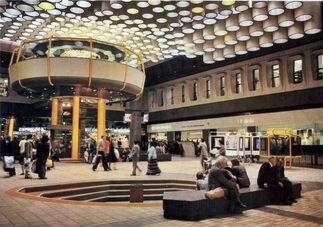
Orbit One Central, as it looked circa 1985
At the center of the station was Orbit One Central, an indoor mini-mall where guests could shop for futuristic souvenirs, sample a variety of freeze-dried treats at the Cosmonaut Cafe, or just relax on padded benches and watch galaxies and nebulae drift by through wall-length windows.
Orbit One Central also offered a wide variety of interactive activities, which evolved to keep pace with developing technology throughout OmniPark's 25 years in operation.
At the park's opening in 1977, guests could play with Moog synthesizers and other audiovisual gadgets. In 1985, the exhibits were renovated to feature user-friendly computer terminals that allowed guests to generate colorful geometric imagery and compose digital music. Orbit One Central's activities were revamped for a third time in 1993, to feature touchscreens and computer-animated visuals. A final renovation in 1999 added terminals at which guests could customize 3-D avatars of themselves, and play a virtual reality game in which they navigated a hazardous asteroid field.
Attraction: Nebula Quest[]
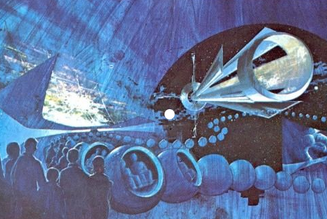
1975 OmniPark Concept art for Nebula Quest ride vehicles
The largest portal opening off Orbit One Central featured an illuminated sign beckoning guests to "Nebula Quest: An Intergalactic Hyperspace Adventure." While waiting in line, guests were treated to an awe-inspiring view of the station's main docking bay, through which they watched starships arrive, dock, unload, and depart for far-off destinations.
Once guests arrived at the ride itself, they boarded spherical vehicles, each seating two guests side-by-side. Upon entering the vehicle and being secured by a lap bar, the vehicles would immediately rotate ninety degrees, turning away from the space station to reveal a breathtaking concave OmniVision vista in which they were suspended far above a looming planet Earth. It was here that guests were introduced to the Navigator, an astronaut of considerable experience.
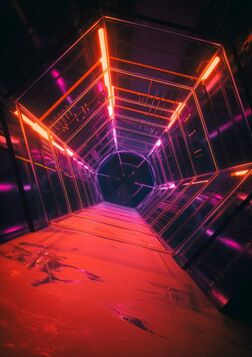
The chamber in which riders underwent "hyperspace jumps," as it looked circa 1985
After the guests had a few moments to take in the sheer scale of outer space, the Navigator revealed that she'd decided to bring them along for a special mission: to attempt to locate a nebula that was photographed by one of the station's telescopes, but had then vanished mysteriously. The search for this lost nebula, the Navigator explained, provided an ideal opportunity to test-drive the Physicist's new Hyperspace Ring, and explore the cosmos firsthand.
The ride vehicles then undertook the first of several "hyperspace jumps" -- which were actually rotations through a chamber positioned opposite the OmniVision screen. Disoriented by a field of laser light accompanied by digital sound effects, along with dizzying rotations of the ride vehicle itself (accomplished by a proprietary gyroscopic system), few guests realized their ride vehicles were simply rotating back around to the same enormous OmniVision screen, where different nebulae, galaxies and constellations were projected at each "destination."
Riders emerged from the first hyperspace jump to arrive at a view of the solar system from just beyond the planet Pluto. After allowing them a moment to take in the view, the Navigator announced excitedly that the first test of the hyperspace system had successfully transported them four billion miles from the sun -- farther than any living beings had ever traveled before. They were the first humans, she explained in awed tones, ever to personally see their own solar system from the outside.
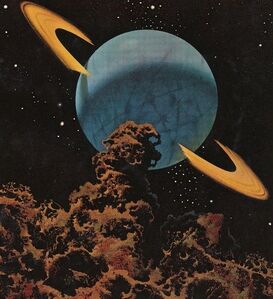
1975 OmniPark concept art for one of the nebular vistas
Now it was time to go in search of the missing nebula. A series of rapid hyperspace jumps transported riders to famous interstellar structures such as the Crab Nebula, the Cat's Eye Nebula, and the Hourglass Nebula, all visually simulated through chemical photography and projected at impressive scale on the Omnivision screen. At each stop, the Navigator scanned her instruments for the missing nebula, but was unable to find any trace of it.
The only solution, the Navigator explained (in an increasingly unhinged tone) was to go farther out in hopes of gaining a clearer view. The ride vehicles then undertook their largest hyperspace jump yet, emerging outside the Milky Way Galaxy itself.
As riders watched the galaxy rotate solemnly beneath them, the Navigator announced that here, 50,000 light years from Earth, she'd finally got a faint reading on the lost nebula. Although she now realized it lay outside our galactic supercluster, the Navigator explained that, "since we've come this far," she and the riders deserved to see it with their own eyes.
Further jumps transported guests to the Andromeda Galaxy, 2.5 million light years from earth -- then outside the Virgo Supercluster, which contains the Milky Way and Andromeda galaxies along with thousands of others.
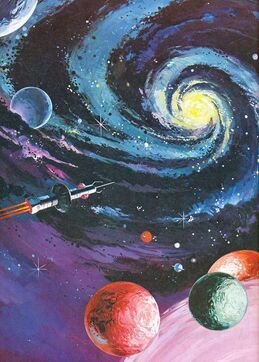
1975 OmniPark Concept art Nebula Quest
At this point, the distressed Navigator revealed she'd been hiding a key piece of information from the riders: each of these hyperspace jumps was taking them not only farther out in space, but also further forward in time. While this effect was negligible within the solar system and its immediate environs, these million-light-year jumps had taken them millions of years into the future. Everyone they had ever known was long-dead. Even the planet Earth itself might have plunged into the sun by now.
A hyperspace jump back into the Virgo Supercluster revealed that the Navigator's worst fears were correct: no known galaxies remained. The Milky Way and Andromeda Galaxies had long-since collided, merging into a new galaxy while sending untold billions of worlds and solar systems hurtling outward into deep space. Further jumps transported riders back to the Hourglass and Cat's Eye Nebulae, which had taken on strange new shapes as millions of years had passed.
"One of two things will happen: either we are obliterated ...or we become gods!"
— The Navigator
And this time-warping effect, the Navigator admitted, explained why she was unable to find the lost nebula: like everything else in the universe, it was constantly changing, slowly falling apart, giving in to entropy. "Nothing lasts forever," she explained. "Nothing is static; nothing is constant. Not the planet Earth, not our sun, or our galaxy; not even the universe itself. The only thing that is truly real ...is change itself."
But there was one possible hope, the Navigator declared -- an idea so crazy it just might work: she could launch them on a jump that took them straight through a black hole, which (according to one fringe theory) might punch a hole outside the physical universe itself, enabling the Navigator to plot a course back around the curve of spacetime, and back to the year from which they'd left. "One of two things will happen," the Navigator cried, in one of OmniPark's most memorable lines: "either we are obliterated ...or we become gods!"
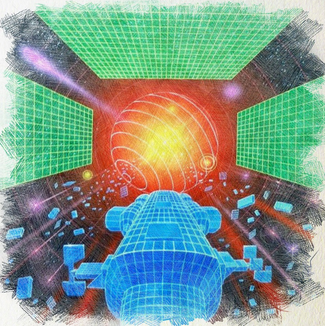
Concept art for the great hyperspace leap "outside spacetime"
This final hyperspace jump took riders straight "through the singularity" of a black hole, and out across a "curved membrane of spacetime," simulated through an elaborately distorted laser grid projected across the OmniVision screen.
After a rotating gyroscopic journey along that curve, the Navigator managed to "punch a hole" back into the physical universe, at the "time coordinates" from which the expedition had originally departed.
At last, riders converged on the Milky Way Galaxy -- which had returned to its familiar shape -- then on the solar system, then back to the planet Earth, above which the space station rotated serenely. The ride vehicles returned to the docking bay.
As guests disembarked from their vehicles, the Navigator could be heard in the background, shouting insanely that she had "seen Time from the outside," as she was subdued and dragged away by medical personnel.
Controversy and Renovations[]
Although guest polls found that Nebula Quest was one of OmniPark's most popular attractions throughout the late 1970s [citation needed], the ride soon came under heavy fire from the scientific community for its "highly questionable" astrophysics.
"The singularity of a black hole is just that: a singular point in spacetime," astrophysicist Carl Sagan wrote in his 1980 Scientific American article The Real Science Behind OmniPark. "Talking about 'punching through' it makes no sense, any more that one could 'punch through' an electron with a pencil."
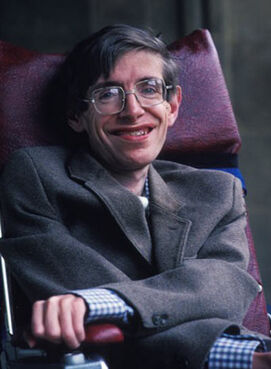
Astrophysicist Stephen Hawking
Stephen Hawking offered a somewhat more generous (but also critical) take in his 1988 book A Brief History of Time, which mentioned Nebula Quest in passing: "While it is mathematically possible that a black hole could, in fact, serve as a hole through spacetime," he wrote in chapter 10, "all the matter in your body would be compressed to an infinitely tiny mass of infinite density by the time you entered it: not exactly an ideal state in which to travel."
Nebula Quest's concepts of traveling "outside the universe" and along the "outer curve of spacetime" also attracted harsh criticism from physicists, many of whom protested that OmniPark had no business masquerading as an educational theme park if its attractions were based on such nonsensical premises [citation needed]. In addition, many guests complained that the gyroscopic rotations of the final hyperspace journey made them nauseous [citation needed].
In a rare instance of openly bowing to public criticism, OmniPark management formally recruited a board of scientific advisors in 1989, and revised the ride's plot according to their critiques. The revamped version of Nebula Quest entirely eliminated the concept of traveling millions of years into the future. Instead, new recordings of the Navigator explained these climactic scenes in terms of space travel, not time travel; and the return to Earth was accomplished via a series of (apparently more plausible) ordinary hyperspace jumps.
Evidence of the attraction's original plot, and of the special effects that accompanied it, survives only in the forms of storyboards and poorly preserved film recordings.
